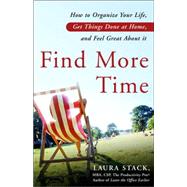
Note: Supplemental materials are not guaranteed with Rental or Used book purchases.
Purchase Benefits
What is included with this book?
LAURA STACK, M.B.A., C.S.P., is an internationally recognized productivity expert and author of Leave the Office Earlier. As president of Celebration Presentations, she gives over 100 seminars and keynote speeches a year on reducing stress and information overload, as well as getting organized and balancing work and family. She lives in Denver, Colorado.
| Acknowledgments | ix | ||||
| Introduction | 1 | (16) | |||
|
17 | (30) | |||
|
47 | (37) | |||
|
84 | (39) | |||
|
123 | (34) | |||
|
157 | (41) | |||
|
198 | (51) | |||
|
249 | (38) | |||
|
287 | (36) | |||
| Conclusion | 323 |
The New copy of this book will include any supplemental materials advertised. Please check the title of the book to determine if it should include any access cards, study guides, lab manuals, CDs, etc.
The Used, Rental and eBook copies of this book are not guaranteed to include any supplemental materials. Typically, only the book itself is included. This is true even if the title states it includes any access cards, study guides, lab manuals, CDs, etc.
Excerpted from Find More Time: How to Get Things Done at Home, Organize Your Life, and Feel Great about It by Laura Stack
All rights reserved by the original copyright owners. Excerpts are provided for display purposes only and may not be reproduced, reprinted or distributed without the written permission of the publisher.